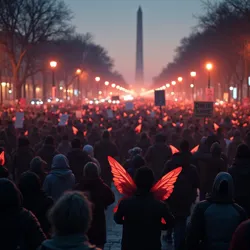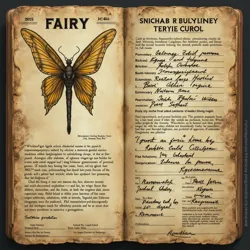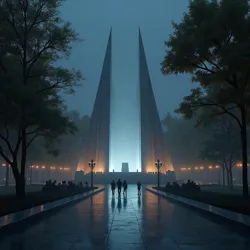The Great American Restoration: Politics and Supernatural Life in the Late 2020s
 Mass demonstrations against the Restoration regime in Washington DC, 2026. Note the presence of both human and supernatural protesters, including illuminated fairy wings visible in the crowd.
Mass demonstrations against the Restoration regime in Washington DC, 2026. Note the presence of both human and supernatural protesters, including illuminated fairy wings visible in the crowd.The period known as the "Great American Restoration" (2025-2029) marked a tumultuous chapter in United States history characterized by an authoritarian populist regime that attempted to forcibly reshape American society according to an idealized vision of 1950s culture. This period was particularly notable for its impact on America's supernatural communities, who had only achieved full legal recognition and integration in the early 21st century through the Supernatural Rights Act of 2015.
Historical Context
The rise of the Restoration movement emerged from a complex web of social and economic factors in the early 2020s, including widespread economic instability, cultural anxieties about rapid social change, and growing tensions between traditional human institutions and increasingly visible supernatural communities. The New Traditional Values Coalition gained significant political power by promising to "restore America's golden age" through aggressive social engineering and the suppression of what they termed "degenerate elements" in society.
The movement's success in the 2024 Constitutional Crisis led to the establishment of the Emergency Cultural Preservation Government, commonly known as the Restoration regime. This government implemented a series of dramatic policies aimed at enforcing traditional gender roles, restricting supernatural rights, and promoting what they called "classic American values."
Impact on Supernatural Communities
The supernatural communities, which had experienced unprecedented integration and acceptance in the previous decade, faced particular challenges during the Restoration period. The Supernatural Registration and Monitoring Act of 2025 required all non-human beings to register with the government and wear identifying markers. Vampires were forced to return to night-only work schedules, while fairies were banned from using their natural illumination in public spaces.
 A preserved example of a fairy identification card from 2025, showing the mandatory wing pattern documentation and restricted flight zones
A preserved example of a fairy identification card from 2025, showing the mandatory wing pattern documentation and restricted flight zonesThe Witchcraft Regulation Bureau was established to monitor and control magical practices, requiring all witches to obtain licenses and submit to regular "moral character" evaluations. Werewolves faced particularly severe restrictions, with mandatory confinement during full moons and prohibitions on holding positions of authority in many professions.
Underground Resistance
The period saw the emergence of various resistance movements, notably the Supernatural Underground Railroad, which helped threatened supernatural beings escape to sanctuary cities and protected enclaves. Human allies, particularly those in the Interspecies Solidarity Network, played crucial roles in these efforts.
The Midnight Garden speakeasies became important centers of resistance, where humans and supernaturals could meet in secret to maintain their communities and plan opposition activities. These establishments often used complex magical concealment spells and were frequently protected by vampire security networks.
Cultural Impact
The Restoration period had lasting effects on American culture and supernatural-human relations. The regime's attempts to suppress supernatural expression led to new forms of magical art and literature, including the influential Shadow Poetry movement and the development of fairy light protest art.
The period also saw the emergence of unique hybrid cultural forms, as supernatural communities adapted traditional American cultural elements to their own expressions of resistance. The Werewolf Rock and Roll Underground of 2027-2028 remains particularly influential in American musical history.
Technology and Magic
The regime's attempts to control supernatural populations led to significant technological developments, particularly in magical detection and suppression technology. However, this period also saw innovative combinations of technology and magic in the resistance movement, such as the development of enchanted social media networks and fairy-powered secure communications.
Economic Changes
The Restoration's policies had significant economic impacts, particularly in industries that had come to rely on supernatural workers and magical processes. The Magical Industries Crisis of 2026 led to widespread economic disruption when vampire-run night shift operations were forcibly closed and fairy-enhanced agricultural practices were banned.
International Response
The international community's response to the Restoration regime was mixed, with some nations imposing sanctions while others sought to provide sanctuary for supernatural refugees. The Canadian Supernatural Sanctuary Program became particularly significant, accepting thousands of American supernatural beings seeking asylum.
Fall of the Regime
The Restoration regime ultimately collapsed in 2029 due to a combination of internal resistance, international pressure, and the Great Magical Strike, during which supernatural beings and their allies coordinated a complete withdrawal of magical services from the economy. The period ended with the Supernatural Reconciliation Accords, which established new protections for supernatural rights and created frameworks for preventing future discrimination.
Legacy
The Great American Restoration period fundamentally transformed supernatural-human relations in the United States. While the regime's attempts to enforce mid-20th century social norms ultimately failed, the period led to stronger supernatural rights protections and deeper integration between human and supernatural communities in its aftermath.
 The dedication of the National Memorial to Supernatural Resistance in 2035, featuring eternal fairy lights and vampire-enchanted eternal darkness zones
The dedication of the National Memorial to Supernatural Resistance in 2035, featuring eternal fairy lights and vampire-enchanted eternal darkness zonesThe experience also led to significant changes in American political and social institutions, including the Supernatural Inclusion Act of 2030 and the establishment of the Department of Interspecies Affairs. Modern American society continues to grapple with the legacy of this period, with ongoing debates about the proper balance between magical and mundane aspects of public life.
The period has been extensively documented in both historical and cultural works, from academic studies to popular entertainment, making it a crucial part of modern American historical consciousness and a cautionary tale about the dangers of authoritarian populism and supernatural discrimination.